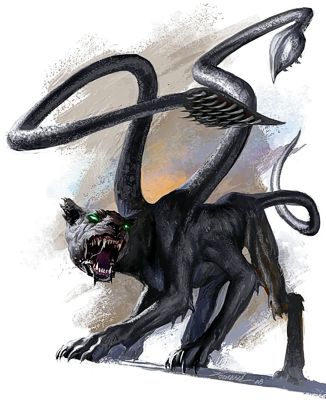

Monstrous Manual

| Climate/Terrain: | Temperate mountains |
|---|---|
| Frequency: | Very rare |
| Organization: | Pack |
| Activity Cycle: | Any |
| Diet: | Carnivorous |
| Intelligence: | Semi-(2-4) |
| Treasure: | (D) |
| Alignment: | Lawful evil |
| No. Appearing: | 2-5 (1d4+1) |
| Armor Class: | 4 |
| Movement: | 15 |
| Hit Dice: | 6 |
| THAC0: | 15 |
| No. of Attacks: | 2 |
| Damage/Attack: | 2-8 (2d4)/2-8 (2d4) |
| Special Attacks: | Nil |
| Special Defenses: | -2 on opponent’s attack roll |
| Magic Resistance: | Nil |
| Size: | L (8-12’ long) |
| Morale: | Elite (13-14) |
| XP Value: | 975 |
The displacer beast is a magical creature that resembles a puma with two powerful black tentacles growing from its shoulders. Very rare, they stay far from human habitations.
The displacer beast has the blue-black coloring of a dark panther,and a long cat-like body and head. Females range in length from 8 to 9 feet, and weigh 450 pounds; males are 10 to 12 feet long, and weigh up to 500 Lbs. They have 6 legs. Tentacles are tipped with rough horny edges that can inflict terrible wounds. Their eyes glow bright green, even after death.
Combat: The displacer beast is a fierce, savage creature that hates all forms of life. Highly aggressive, the displacer beast will attack on sight, using its tentacles to inflict 2-8 (2d4) points of damage to its victims.
Their main advantage in combat is their magical power of displacement, which allows them to appear to be some 3 feet from their actual location. Anyone attacking a displacer beast does so at -2 on his attack roll. In addition, the beasts save as 12th-level fighters; adding +2 to their die rolls.
To determine the true position of the displacer beast and its illusion, roll 1d10. On 1-5, the illusion is in front of the creature, 6-7 to the creature’s left, 8-9, to the right. On 10, the illusion is behind the beasts actual position. Although this ability is magical, the beastˆs location can not be determined by dispel or detect magic. Only true seeing will reveal its position.
Displacer beasts will not use their claws or teeth unless near death, or when in combat with a very large opponent. If they do employ them, each claw does 1-3 points of damage, and each bite does 1-8 points of damage.
Habitat/Society: Displacer beasts are carnivores. Unless they are raising young, they usually run in packs, carving a savage swath of destruction as they go. They hate all life, and will sometimes kill purely for pleasure. Fierce and vicious as they are, however, displacer beasts never fight among themselves. The pack is a well-run and highly efficient killing machine. When encountered in packs, displacer beasts are more than a match for many large creatures and have been known to make a meal of orcs, goblins, and bands of men. Any creature entering their territory is viewed as potential prey.
Displacer beasts mate in the autumn, and the young are born in spring. A mated pair of displacer beasts makes its home in a cave, producing litters of 1-4 young. The cubs, about the size of domestic cats, are born without tentacles and reach maturity, though not full size, within 4 months. They remain in the cave until their displacement abilities are fully developed. This is followed by a two month period during which the cubs are taught how to hunt. When this is completed, the family group disbands and the monsters wander off to join separate packs. While raising young, the monsters are fiercely protective of their lairs. One adult always remains with the cubs, usually the female, while the other goes off to hunt. Dead prey is dragged back to the lair to be eaten by the family. Lairs are littered with the bones, equipment, and the treasures of its victims.
Naturally vicious and almost evil at times, displacer beasts harbor an undying hatred of blink dogs. Many theories attempt to account for this enmity. Some sages believe it springs from antipathy in temperaments – the lawful good blink dog would naturally be the enemy of a creature as savage and destructive as the displacer beast. Others argue that it is the displacement and blink abilities which cause this antipathy – the two abilities, when in close proximity, somehow stimulate the nervous system and produce hostile reactions. Encounters between the two breeds are rare however, since they do not share the same territory.
Ecology: Displacer beasts have little to fear from other large predators, save perhaps trolls or giants. Some wizards and alchemists value their hides for use in certain magical preparations, and will offer generous rewards for them. The eyes of a displacer beast are a highly prized, if uncommon, good luck charms among thieves who believe that they will protect the bearer from detection.
